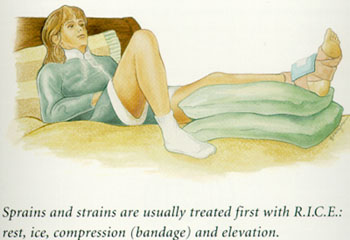Sprains Strains and Soft Tissue Injuries
When you participate in sports and physical fitness activities, you can injure the soft tissues of your body. Even simple everyday activities can damage these ligaments, tendons and muscles.
Some of the soft-tissue injuries you're most likely to experience include:
- sprains
- strains
- contusions
- tendonitis
- bursitis
- stress injuries
Any of these can be the result of a single episode, such as a fall, a sudden twist or a blow to the body. You might also sustain one or more of these injuries because of repeated overuse, such as in ongoing athletic activities. In this case, small amounts of body stress accumulate slowly but steadily. The result can be damage and pain.
Here are some of the injuries you're most likely to experience, along with suggested ways of treating them.
Sprains
The joints of your body are supported by ligaments - strong bands of connective tissue that connect one bone to another. A sprain is a simple stretch or tear of the ligaments.
The areas of your body that are most vulnerable to sprains are your ankles, knees and wrist. A sprained ankle can occur when your foot turns inward. This can put extreme tension on the ligaments of your outer ankle and cause a sprain. A sprained knee can be the result of a sudden twist. Wrist sprains most often occur when you fall on an outstretched hand.
 |
Most mild sprains heal with "R.I.C.E." (rest, ice, compression and elevation) and exercise. Moderate sprains may also require a period of bracing. The most severe sprains may require surgery to repair torn ligaments.
|
Strains
Your bones are supported by a combination of muscles and tendons. Tendons connect muscles to bones. A strain is the result of an injury to either a muscle or a tendon, usually in your foot or leg. The strain may be a simple stretch in your muscle or tendon, or it may be a partial or complete tear in the muscle-and-tendon combination.
The recommended treatment for a strain is the same as for a sprain-rest, ice, compression and elevation. This should be followed by simple exercises to relieve pain and restore mobility. For a serious tear, you may need surgical repair.
Contusions
A contusion is a bruise caused by a blow to your muscle, tendon or ligament. The bruise is caused when blood pools around the injury and discolors your skin.
Most contusions are mild and respond well when you rest, apply ice and compression, and elevate the injured area. If symptoms persist, medical care should be sought to prevent permanent damage to the soft tissues.
Tendonitis
Inflammation is a healing response to injury, and is usually accompanied by swelling, heat, redness and pain. An inflammation in a tendon or in the tendon covering is called tendonitis. What usually causes tendonitis is not just a single injury but a series of small stresses that repeatedly aggravate the tendon.
Professional baseball players, swimmers, tennis players and golfers are susceptible to tendonitis in their shoulders and arms. Soccer and basketball players, runners and aerobic dancers are prone to tendon inflammation in their legs and feet.
Tendinitis may be treated by rest to eliminate stress, anti-inflammatory medication, steroid injections, splinting, and exercises to correct muscle imblanace and improve flexibility. Persistent inflammation may cause damage to the tendon which may necessitate surgical correction.
Bursitis
A bursa is a sac filled with fluid. It is located between a bone and a tendon or muscle, and it allows the tendon to slide smoothly over the bone.
Repeated small stresses and overuse can cause the bursa in your shoulder, elbow, hip, knee or ankle to swell. This swelling and irritation is called bursitis, and many people experience it in association with tendonitis.
Bursitis can usually be relieved by rest and possibly with anti-inflammatory medication. Some orthopaedic surgeons also inject the bursa with additional medication to reduce the inflammation.
Stress fractures
When one of your bones is stressed by overuse, tiny breaks in the bone can occur. The injury is termed a stress fracture. Early symptoms may be pain and sweling in the region of the stress fracture. The bones of your lower leg and foot are particularly prone to stress fractures. The fracture may not be seen on initial routine ex-rays, requiring a bone scan to obtain the diagnosis.
These injuries are treated by rest, activity modification, cast immobilization, and rarely by surgery.
Good Care
Your orthopaedist is a medical doctor with extensive training in the diagnosis and nonsurgical and surgical treatment of the musculoskeletal system, including bones, joints, ligaments, tendons, muscles and nerves.
This brochure has been prepared by the American Academy of Orthopaedic Surgeons and is intended to contain current information on the subject from recognized authorities. However, it does not represent official policy of the Academy, and its text should not be construed as excluding other acceptable viewpoints.
If you're an athlete or a fitness enthusiast, you should pay close attention to your body's warning signs. Fatigue and pain are usually a signal that you're pressing too hard. Be sure to stretch thoroughly before your work-out, and stop before you're exhausted.
Stress injuries can also result from poor muscle balance, lack of flexibility or because of weakness in soft tissues cause by previous injuries. These injuries to the muscle, bone ligaments, and tendons may require a prolonged amount of time to heal in spite of appropriate care.
Consult your orthopaedic surgeon for treatment of these soft tissue and bone injuries. Besides treating the problem, he or she can develop a program of exercise or rehabilitation to restore function.
February 2002
All Information Copyright © American Academy of Orthopaedic Surgeons
www.aaos.org